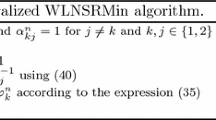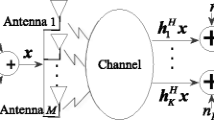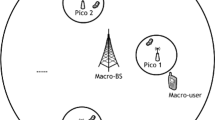Abstract
The outer boundary of the achievable rate region for multiple-input single-output (MISO) interference channel (IC) is Pareto boundary, and all points on the Pareto boundary can be obtained by solving weighted sum rate maximization problem. Unfortunately, since the optimization problem is non-convex, it is generally very difficult to obtain the solutions without performing an exhaustive search. In this paper, the achievable rate region of the two-user MISO IC is considered. Firstly, by minimizing the interference power leaked to the other receiver for fixed useful signal power received at the intended receiver, the non-convex optimization problem is converted into a family of convex optimization problems. Secondly, after some conversions, the closed-form solutions to all Pareto optimal points are derived using the Lagrange duality theory, and the only computation involved is to solve a basic quadratic equation. Then, the antenna reduction is performed to further simplify the process of derivation. In order to avoid the exchange of channel state information (CSI) between base stations, a distributed iterative beamforming strategy which can achieve a approximate Pareto optimal outcome with only a few iterations is also proposed. Finally, the results are validated via numerical simulations.






Similar content being viewed by others
References
Li, F. (March 2012). Array processing for multi-user multi-antenna interference channels using precoders. Wireless Personal Communications, Online First, 27.
Jorswieck, E., Larsson, E., Danev, D. (Oct. 2008). Complete characterization of the pareto boundary for the MISO interference channel. IEEE Transactions on Signal Process. 56(10), 5292–5296.
Yue, D.-W., Zhang, Q. T., & Song, S. H. (2010). Capacity of correlated MISO channels with correlated co-channel interference and noise. Wireless Personal Communications, 65(2), 253–263.
Shang, X., Chen, B. (2007). Achievable rate region for downlink beamforming in the presence of interference. In: Proceedings IEEE 41st Asilomar conference Signals, Systems and Computers (pp. 1684–1688) CA: Pacific Grove.
Lindblom, J., Karipidis, E., Larsson, E. G. (Sep. 2009). Selfishness and altruism on the MISO interference channel: The case of partial transmitter CSI. IEEE Communications Letters, 13(9), 667–669.
Lindblom, J., Larsson, E. G., Jorswieck, E. A. (Feb. 2010). Parameterization of the MISO IFC rate region: The case of partial channel state information. IEEE Transactions on, Wireless Communications. 9(2), 500–504.
Zakhour, R., Gesbert, D. (Feb. 2009). Coordination on the MISO interference channel using the virtual SINR framework. In Proceedings ITG workshop on smart antennas (WSA’09), Berlin, Germany.
Zakhour, R., Gesbert, D. (Aug. 2010). Distributed multicell-MISO precosing using the layered virtual SINR framework. IEEE Transactions on Wireless Communications, 9(8), 2444–2448.
Shang, X., Chen, B., Poor, H. (July 2011). Multiuser MISO interference channels with single-user detection: optimality of beamforming and the achievable rate region. IEEE Transactions on Information Theory, 57(7), 4255–4273.
Lindblom, J., Karipidis, E., Larsson, E. G. (May 2011). Closed-form parameterization of the Pareto boundary for the two-user MISO interference channel. In Proceedings IEEE international conference acoustics, speech and signal processing (ICASSP) (pp. 3372–3375). Czech: Prague.
Mochaourab, R., Jorswieck, E. (June 2011). Walrasian equilibrium in two-user multiple-input single-output interference channels. In Proceedings of the IEEE ICC (pp. 1–5) Japan: Kyoto.
Annapureddy, V. S., Veeravalli, V. V. (May 2011). Sum capacity of MIMO interference channels in the low interference regime. IEEE Transactions Information Theory, 57(5), 2565–2581.
Vizireanu, D. N., & Preda, R. O. (2013). Is “five-point” estimation better than “three-point” estimation? Measurement, 46(1), 840–842.
Zhang, R., Cui, S. (Oct. 2010). Cooperative interference management with MISO beamforming. IEEE Transactions on Signal Processing, 58(10), 5450–5458.
Tang, M., Long, C., & Guan, X. (2011). Nonconvex optimization for power control in wireless CDMA networks. Wireless Personal Communications, 58(4), 851–865.
Bjornson, E., Jalden, N., Bengtsson, M., Ottersten, B. (Dec. 2011). Optimality properties, distributed strategies, and measurement-based evaluation of coordinated multicell OFDMA transmission. IEEE Transactions on Signal Processing, 59(12), 6086–6101.
Udrea, R. M., Vizireanu, D. N., Ciochina, S. (2008). An improved spectral subtraction method for speech enhancement using a perceptual weighting filter. Digital Signal Processing vol. 18 (pp. 581–587). Elsevier.
Udrea, R. M., Vizireanu, D. N., Ciochina, S., & Halunga, S. (2008). Nonlinear spectral subtraction method for colored noise reduction using multi-band Bark scale. Signal Processing, Elsevier, 88(5), 1299–1303.
Karipidis, E. Grundinger, A., Lindblom, J., Larsson, E. G. (Dec. 2009). Pareto-optimal beamforming for the MISO interference channel with partial CSI. In: Proceedings IEEE international workshop on computational advances in multi-sensor adaptive processing (CAMSAP) (pp. 5–8). Aruba: Dutch Antilles.
Rich, B., & Schmidt, P. A. (2004). Schaum’s Outline of theory and problems of elementary algebra. NY: The McGraw-Hill Companies.
Karipidis, E., Larsson, E. G. (June 2010). Efficient computation of the Pareto boundary for the MISO interference channel with perfect CSI. In Proceedings WiOpt, (pp. 573–577) Avignon, France.
Li, J., & Stoica, P. (2005). Robust adaptive beamforming. London: Wiley.
Riba, J., Goldberg, J., Vazquez, G. (Jan. 1997). Robust beamforming for interference rejection in mobile communications. IEEE Transactions on Signal Processing, 45(1), 271–275.
Pao, W.-C., Chen, Y.-F., Chan, C.-Y. (April 2012). Power allocation schemes in OFDM-based femtocell networks. Wireless Personal Communications, Online First, 13.
Grant, M., Boyd, S. (December 2010). Cvx Users’ Guide for cvx version 1.21. build 804e ed..
Huang, F., Wang, Y., Geng, J., & Yang, D. (2012). Multi-cell optimal downlink beamforming algorithm with per-base station power constraints. Wireless Personal Communication, 62(4), 893–906.
Acknowledgments
This work was supported in part by the National Key Special Program under Grants 2012ZX03003005-003 and 2012ZX03001036-004, by the National Science Foundation of China (61221002, 61271205, 61101086, 61101082), and by the Scientific Research Foundation of Graduate School of Southeast University (YBJJ1212).
Author information
Authors and Affiliations
Corresponding author
Appendices
Appendix A
1.1 Proof of Proposition 1
Write the direct link channel vector \({\tilde{\mathbf{h}}}_{kk}\) as a scalar multiple of the interference channel vector \({\tilde{\mathbf{h}}}_{k{\overline{k}}}\) plus a vector \({\tilde{\mathbf{h}}}_{k{\overline{k}}}^\bot \) which is orthogonal to \({\tilde{\mathbf{h}}}_{k{\overline{k}}}\)
Since \({\tilde{\mathbf{h}}}_{k{\overline{k}}}^\bot \) is orthogonal to \({\tilde{\mathbf{h}}}_{k{\overline{k}}}\), we can obtain
Solving the Eq. (18) for \(\omega _k\), we can get
Then the orthogonal vector \({\tilde{\mathbf{h}}}_{k{\overline{k}}}^\bot \) can be expressed as
Now define \(\mathbf{U}_k\) as a unitary matrix. Let \(\frac{{\tilde{\mathbf{h}}}_{k{\overline{k}}}}{\left\Vert {{\tilde{\mathbf{h}}}_{k{\overline{k}}}} \right\Vert}\) be the first column and \(\frac{{\tilde{\mathbf{h}}}_{k{\overline{k}}}^\bot }{\left\Vert {{\tilde{\mathbf{h}}}_{k{\overline{k}}}^\bot } \right\Vert}\) be the second column of the \(\mathbf{U}_k\). With the definition of
the received signal at \(\text{ MS}_k\) in (1) can be rewritten as (22).
From the Eq. (22), we can find that the received signal \(y_k\) doesn’t depend on the channel inputs \(\bar{{w}}_{k,3} s_k\) to \(\bar{{w}}_{k,N_t } s_k\) and \(\bar{{w}}_{{\overline{k}},3} s_{{\overline{k}}}\) to \(\bar{{w}}_{{\overline{k}},N_t } s_{{\overline{k}}}\) where \(\bar{{w}}_{k,i}\) denotes the \(i\text{ th}\) entry of beamforming vector \({\overline{\mathbf{w}}}_k\), and hence, they can be dropped. Define
and remove the irrelevant dimensions, we can obtain the following standard form of the equivalent channel
Consequently, the parameters of the equivalent channel can be expressed as the Eqs. (3), (4) and (5) respectively. \(\square \)
Appendix B
1.1 Proof of Theorem 1
Inspired by [19], we give the following proof. From the definition of the Pareto optimality, we know that every point on the Pareto boundary is uniquely defined when either of the user rate is known. Hence, we can derive the Pareto boundary by solving the optimization problem of maximizing one rate for a given value of the other rate
From the viewpoint of game theory [21], the minimum \(\underline{R}_k\) and maximum \(\overline{R} _k\) Pareto optimal rates of \(\text{ MS}_k\) can be explicitly written as functions of the selfish (MRT) and altruistic (ZF) transmit strategies with full transmit power used as follows
As long as \(R_k\) is chosen in the range \(\left[ {\underline{R}_k ,\overline{R} _k } \right]\), there always exists a feasible solution to optimization problem of (25).
Assume that the Pareto optimal beamforming vector \(\mathbf{w}_{{\overline{k}}}^{*} \) known, the problem (25) reduces to
where the optimization is only with respect to \(\mathbf{w}_k\). From the expression of user rate in (7), we can find that \(R_{{\overline{k}}}\) is monotonously decreasing with the interference power from \(\text{ BS}_k\) and \(R_k\) is monotonously increasing with the useful signal power from \(\text{ BS}_k\) while useful signal power and interference power from \(\text{ BS}_{{\overline{k}}}\) are fixed. Thus, the optimization problem of (28) can be equivalently written as
where \(u_k^{*}\) is the correspondingly useful signal power according to \(R_k^{*}\). So, through minimizing the interference power subject to a specific bound \(u_k\) defined in (10), we can obtain the Pareto optimal points. \(\square \)
Appendix C
1.1 Proof of Theorem 2
The problem (9) can be rewritten as
Since single-antenna receivers assumed, the rank of matrix \(\frac{\mathbf{h}_{kk} }{\sqrt{u_k }}\left( {\frac{\mathbf{h}_{kk} }{\sqrt{u_k }}} \right)^{H}\) is one. Thus the first constraint can be replaced by the linear constraint \(\mathbf{w}_k^H \frac{\mathbf{h}_{kk} }{\sqrt{u_k }}=1\) [22, 23], and the problem (30) reduces to
Set
where \(b=\frac{\left\Vert {\widetilde{\mathbf{h}}_{{\overline{k}}k} } \right\Vert^{2}}{\left\Vert {\widetilde{\mathbf{h}}_{{\overline{k}}{\overline{k}}} } \right\Vert^{2}},\,m=\frac{\widetilde{\mathbf{h}}_{kk}^H \widetilde{\mathbf{h}}_{k{\overline{k}}} }{\left\Vert {\widetilde{\mathbf{h}}_{kk} } \right\Vert\left\Vert {\widetilde{\mathbf{h}}_{k{\overline{k}}} } \right\Vert}\) and \(n=\frac{\widetilde{\mathbf{h}}_{kk}^H \widetilde{\mathbf{h}}_{k{\overline{k}}}^\bot }{\left\Vert {\widetilde{\mathbf{h}}_{kk} } \right\Vert\left\Vert {{\tilde{\mathbf{h}}}_{k{\overline{k}}}^\bot } \right\Vert}\). The Lagrangian of (31) is
where \(\lambda \) and \(\mu \) are the Lagrange multipliers associated with the problem (31).
From the Karush-Kuhn-Tucker (KKT) conditions [24–26], we can obtain
Since the primal problem (9) is convex, all solutions to the KKT conditions will yield Pareto optimal points [25]. From Eq. (35), we get
where \(\mathbf{I}\) denotes the identity matrix of size \(N_t \times N_t\). Submit (38) into (36) and (37), we get
From the expression of \(\mathbf{B}\) defined in (32), we can get the expression of \(\left( {\mathbf{B}+\mu \mathbf{I}} \right)^{-1}\) and \(\left( {\mathbf{B}+\mu \mathbf{I}} \right)^{-2}\) as
On substituting (41) and (42) into (39) and (40), we have
and we can equivalently rewrite (45) as
where \(e=m^{H}m\) and \(f=n^{H}n\) which all are constants.
Then, we can calculate the optimal beamforming vector by Eqs. (38), (39) and (46). \(\square \)
Rights and permissions
About this article
Cite this article
Li, J., Wang, D., Zhu, P. et al. Closed-Form Solutions to the Pareto Boundary and Distributed Beamforming Strategy for the Two-User MISO Interference Channel. Wireless Pers Commun 72, 175–190 (2013). https://doi.org/10.1007/s11277-013-1007-1
Published:
Issue Date:
DOI: https://doi.org/10.1007/s11277-013-1007-1




